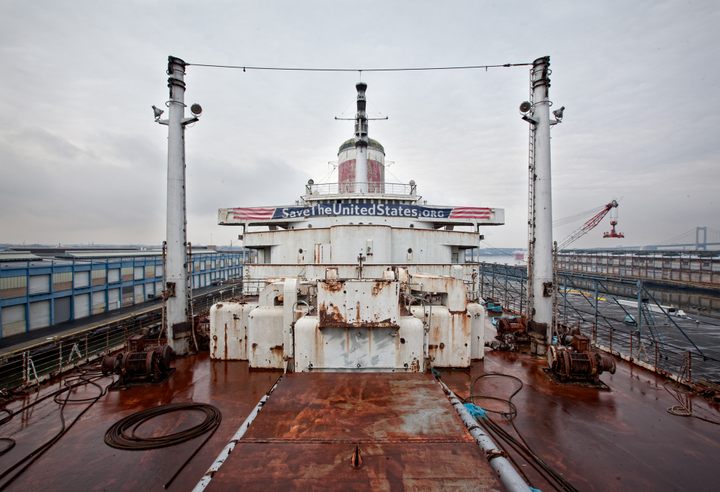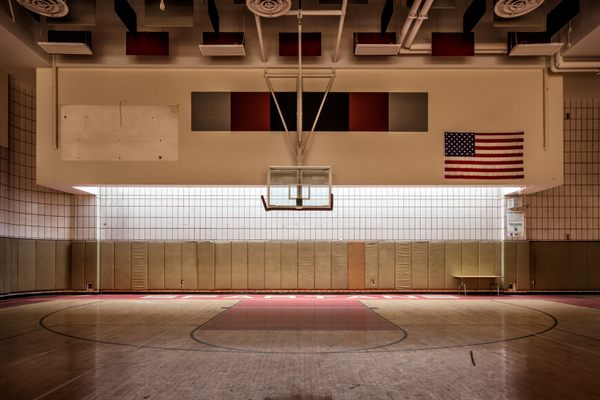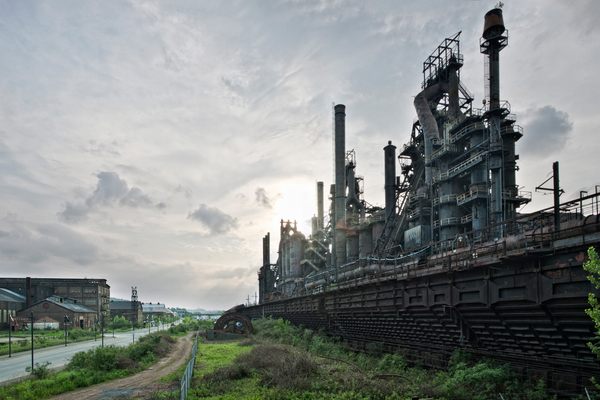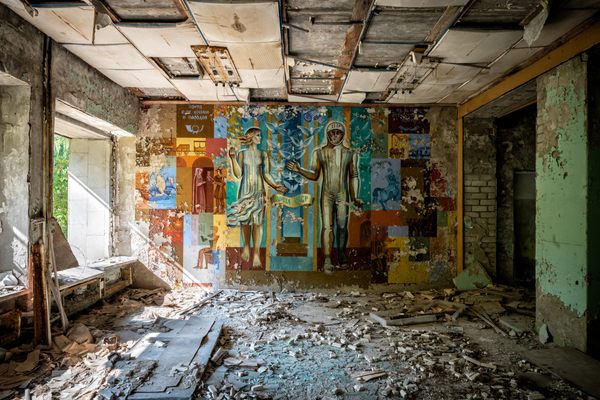
The SS United States Heads Into Unknown Waters
After decades in a Philadelphia shipyard, the last great American ocean liner may be destined for the seafloor.

Walking toward the SS United States, I was taken aback by how unimaginably large and grand the liner was. It was something you really couldn’t fully appreciate from far away. The rusty red, white, and black prow towered above me like the blade of a giant knife, and the funnels alone were the height of a six-story building. It was the largest liner constructed on United States soil, and the fastest too. It was like standing next to the Titanic, except the SS United States was actually over 100 feet longer. Something statistics and numbers can’t convey, though, is the sense of awe this ship inspires. My heart was beating wildly as I walked up the gangplank, flanked by two executives from Norwegian Cruise Lines. This wasn’t any ship I was about to board, it was a legend. And it’s the last of its kind.
Even as I had pulled up to the gate of the Port Authority terminal in Philadelphia on a hot September morning in 2008, I wasn’t quite sure how I had managed to get permission to photograph the SS United States. I was greeted, if you can call it that, by a gruff supervisor: “Nobody gets on that thing, not even my own workers,” he said with an accusatory tone. “But, when the man who controls our funding calls and tells us to let someone on, we have to do what he tells us.”


I didn’t really understand it either. I had met a couple at a backyard barbecue a few months earlier who told me that if I was interested in abandoned places, I should try to get access to the SS United States. I laughed—of course I’d love to photograph the derelict ocean liner! It would be a dream come true, but it was impossible. Norwegian Cruise Lines owned it at the time, and I had never heard of anyone arranging access. The couple told me they knew some people who could help and took my number. People often tell me they have connections that can get me into incredible abandoned places, and then nothing comes of it. Even then, I knew enough not to get my hopes up. I was shocked to receive a call a few months later to schedule a time to visit.
As I drove there on the day of the meeting, I couldn’t shake the feeling that somehow the rug would get pulled out from under me at the last minute. It seemed so surreal that something as enormous and majestic as the SS United States was sitting vacant like a glitch in a program that nobody had bothered to patch out. As always, untangling the disparate threads in its story was the only way to even begin to make sense of it.

The SS United States was constructed from 1950 to 1951 for the United States Lines. The U.S. government subsidized $50 million of the $79.4 million in construction costs, with the agreement that, if needed, the liner would serve as a troop ship in wartime. Its design blended the stately profile of liners in previous decades and a sleek, modernist influence prevalent in the interior décor. Terrified that the SS United States might meet the same fate as the SS Morro Castle, Naval architect William Gibbs eschewed the use of wood in any of the ship’s fittings—even the grand piano was aluminum. The SS United States was his favorite creation. Her maiden voyage in 1952, from New York Harbor to Cornwall, England, shattered the transatlantic speed record by nearly 11 hours, winning the Blue Riband—an award for the fastest passenger liner that she holds to this day.
Despite operating for less than two decades, the SS United States boasted an impressive roster of passengers, from celebrities like Marilyn Monroe and Duke Ellington to public figures like Salvador Dali and Walt Disney. The ship even hosted royalty, including Prince Rainier and Grace Kelly and the Duke and Duchess of Windsor. However, the era of which she marked the pinnacle was drawing to a close—the advent of fast and affordable air travel was rendering more leisurely forms of transportation obsolete.
Though an effort was made to transition the SS United States to a role as a cruise ship, United States Lines was hemorrhaging passengers and money. By the 1960s, voyages were canceled due to a lack of interest, and operating costs soared. Transatlantic travel on an ocean liner was a doomed concept, but the SS United States remained popular as a cruise ship into the late 1960s. When United States Lines was bought out in 1968 by Walter Kidd & Co. and government subsidies for the liner were ended, there was no way to continue operating her at a profit.
In 1969, she was moved to Newport News for an overhaul, but shortly after, she was retired after only 17 years in service. There was talk of using the SS United States as a hospital ship, but the idea was deemed too expensive and inefficient. A developer purchased the vacant ship, auctioned off whatever he was able from the interior, and then left the SS United States to deteriorate. The vessel was seized by U.S. marshals and auctioned in 1992. Once again there was talk of refurbishing the ship, this time for use as an ocean liner, but the asbestos removal process further damaged the interior and bankrupted the company that had bought it. Eventually the SS United States was towed to a port in Philadelphia, where she has remained for the last 28 years.


Over the years, there have been no shortage of plans for reuse, but none of the many owners of the SS United States have made any real progress toward repurposing the once-grand ocean liner. Though she was acquired by the SS United States Conservancy in 2009, the possibility that the liner would be scrapped because of exorbitant docking fees—a whopping $80,000 a month—has remained an ever-present threat. Proposals for reuse have ranged from a museum to a “hospitality and cultural space,” or even returning her to use as a cruise ship. Despite hundreds of thousands of dollars of donations over the years, the prohibitive costs of refitting and relocating the liner and the docking fees torpedoed these ideas as the conservancy struggled with realizing its ambitions to save the liner.
In 2021, the precarious situation came to a head: Penn Warehousing, the company that owns the pier where the SS United States is docked, doubled the rent and began litigation to remove the liner. The conservancy and Penn Warehousing sued each other—Penn Warehousing demanded back rent and wished to end its contract, and the conservancy alleged that Penn Warehousing was attempting to force it out of its previous agreement illegally.
This past June, a verdict was reached that Penn Warehousing could terminate the agreement, giving the conservancy a mere 90 days to relocate the ship. It launched a desperate fundraising drive, but the September 12 deadline passed with no clear plan in sight. The most likely outcome now is that the SS United States will be towed to Florida’s Okaloosa County and sunk to create an artificial reef and diving attraction. However, the conservancy has successfully requested an extension of the deadline, alleging that Penn Warehousing was interfering with the deal so that it could sell the ship itself.
There is an undeniable romance to the idea of shipwrecks becoming a habitat for marine life. Many manmade objects have been used for such purposes, from other decommissioned ships to New York City’s retired subway cars. There is a cautious optimism that these projects may help rebuild damaged ecosystems. If it weren’t for the SS United States’ significance as the last representative of an entire era of ocean liners, I’d be much more likely to applaud this idea. Though the SS United States has weathered many storms, there doesn’t appear to be a probable outcome where it isn’t scrapped or sunk—an unfortunate and wasteful end for such a precious specimen of naval history that so many have fought so hard to preserve.


On the day that I first boarded the SS United States, all of this was yet to come. The interior had been gutted, but I was told this was advantageous for someone seeking to repurpose it. Though the hull was rusty, it was still in incredible structural condition for its age and lack of use. I looked out across the sea of South Philly parking lots and marveled at the view, as I imagine that the first passengers on her maiden voyage did—although the world I was looking out upon was very different. The stretch of restaurant chains and big box retailers facing the prow seemed so small and inconsequential, so shabbily built and conceived compared to the majesty of a liner named after the nation that had built it. Though there is a danger in the wistful nostalgia that romanticizes the grandeur of past decades without also adjusting for social and technological progress, it’s hard not to draw a direct contrast between a period where our constructed world was built to withstand centuries and the present, where planned obsolescence is the norm.
In the years since I photographed the SS United States, I’ve read hundreds of comments gleefully advocating for her destruction. I don’t understand it. There are no other ships like her left, and she was built as a symbol of national pride that doesn’t exist in the same way that it did then. Your interpretation of that will no doubt be dictated by your political leanings, but whether you view the SS United States primarily as an emblem of something that is missing from the modern world or as a tangible opportunity to preserve a priceless piece of naval history, one would think that the consensus would be that the ship must be saved. After the liner is gone there will no doubt be dozens of post-mortem analyses, but the result will be the same—that we no longer can experience this beautiful example of maritime technology (unless, perhaps, we can dive to the bottom of the ocean).
My first visit to the SS United States was too brief: it was a hot day, and the Port Authority representative seemed happy to cut it short. Standing outside the chain-link fence surrounding the property, I couldn’t believe I had actually done it: I had been aboard the ship I had dreamed about for years. It hadn’t taken long for me to fall in love with her—and that appreciation has only deepened with more visits and the passage of time. I had hoped that it would be repurposed as a museum or maybe even as a hotel, like the Queen Mary. It seems rather foolish now, but in the face of loss sometimes hope is all we have.
We may all be destined for oblivion at some point or another, and I suppose when you’re at the end of the life of any person or place you care about, there is always the feeling that someone could or should have done more to prevent it. It aches to think that such a long and incredible story is ending. All things do, I guess. There must be a place both to mourn the tragic conclusions of beautiful things in our lives and to celebrate our gratitude for having them for the brief time that we did.


For more photographs and history of the SS United States, visit the gallery on Abandoned America or listen to an episode about it on the Abandoned America podcast.
Matthew Christopher is a writer and photographer who has explored abandoned locations across the globe for two decades, chronicling the lost landmarks in our midst. You can find more of his work on his website Abandoned America or listen to his Abandoned America podcast.
















Follow us on Twitter to get the latest on the world's hidden wonders.
Like us on Facebook to get the latest on the world's hidden wonders.
Follow us on Twitter Like us on Facebook